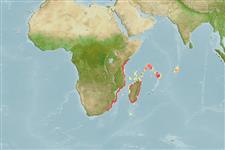>
Perciformes/Scorpaenoidei (Scorpionfishes) >
Bembridae (Deepwater flatheads)
Etymology: Parabembras: Greek, para = the side of + Greek, bembras, -ados = a kind of anchovy (Ref. 45335).
Eponymy: John Benjamin Romer Robinson (1869–1949) was a South African attorney and businessman. [...] (Ref. 128868), visit book page.
More on author: Regan.
Environment: milieu / climate zone / depth range / distribution range
Ökologie
seewasser bathydemersal; tiefenbereich 200 - 600 m (Ref. 6628). Deep-water
Western Indian Ocean, from Durban to at least southern Mozambique, along the east coast of South Africa.
Size / Gewicht / Alter
Maturity: Lm ? range ? - ? cm
Max length : 24.0 cm TL Männchen/unbestimmt; (Ref. 6628)
Rückenflossenstacheln (insgesamt) : 11 - 12; Rückenflossenweichstrahlen (insgesamt) : 8 - 9; Afterflossenstacheln: 3; Afterflossenweichstrahlen: 5.
Life cycle and mating behavior
Geschlechtsreife | Fortpflanzung | Ablaichen | Eier | Fecundity | Larven
Kai, Y. and R. Fricke, 2018. Taxonomic review of the deep water flathead genus Parabembras with description of the new species Parabembras multisquamata from the western Pacific Ocean (Teleostei, Parabembridae). ZooKeys 740:59-76. (Ref. 117904)
IUCN Rote Liste Status (Ref. 130435: Version 2024-1)
Bedrohung für Menschen
Harmless
Nutzung durch Menschen
Fischereien: nicht kommerziell
Tools
Zusatzinformationen
Download XML
Internet Quellen
Estimates based on models
Preferred temperature (Ref.
123201): 9.8 - 15.8, mean 14 °C (based on 20 cells).
Phylogenetic diversity index (Ref.
82804): PD
50 = 1.0000 [Uniqueness, from 0.5 = low to 2.0 = high].
Bayesian length-weight: a=0.00389 (0.00180 - 0.00842), b=3.12 (2.94 - 3.30), in cm total length, based on all LWR estimates for this body shape (Ref.
93245).
Trophic level (Ref.
69278): 3.7 ±0.4 se; based on size and trophs of closest relatives
Fishing Vulnerability (Ref.
59153): Low vulnerability (14 of 100).
